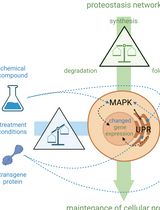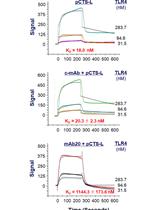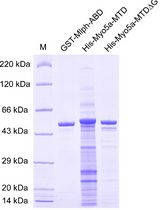- EN - English
- CN - 中文
Native Co-immunoprecipitation Assay to Identify Interacting Partners of Chromatin-associated Proteins in Mammalian Cells
天然共免疫沉淀法鉴定哺乳动物细胞中染色质相关蛋白的“伙伴蛋白质”
发布: 2020年12月05日第10卷第23期 DOI: 10.21769/BioProtoc.3837 浏览次数: 7849
评审: Nathan Rhys JamesMarco Di GioiaAnonymous reviewer(s)

相关实验方案

Cell-Sonar:通过特定蛋白标志物表达变化追踪目标蛋白的简便低成本方法
Sabrina Brockmöller [...] Simone Rothmiller
2025年02月05日 1609 阅读
Abstract
Protein-protein interactions play key roles in nuclear processes including transcription, replication, DNA damage repair, and recombination. Co-immunoprecipitation (Co-IP) followed by western blot or mass spectrometry is an invaluable approach to identify protein-protein interactions. One of the challenges in the Co-IP of a protein localized to nucleus is the extraction of nuclear proteins from sub-nuclear fractions without losing physiologically relevant protein interactions. Here we describe a protocol for native Co-IP, which was originally used to successfully identify previously known as well novel topoisomerase 1 (TOP1) interacting proteins. In this protocol, we first extracted nuclear proteins by sequentially increasing detergent and salt concentrations, the extracted fractions were then diluted, pooled, and used for Co-IP. This protocol can be used to identify protein-interactome of other chromatin-associated proteins in a variety of mammalian cells.
Keywords: Co-immunoprecipitaion (免疫共沉淀)Background
Co-IP is extensively used to unravel the intricate relationship between protein complexes and various chromatin transactions during replication, transcription, and genome maintenance. However, it is challenging to keep labile protein-protein interactions intact during extraction, immunoprecipitation and washing steps of a Co-IP experiment. One way to stabilize labile protein interactions is to treat cells with cell-permeable reversible chemical cross-linker such as dithiobis-succinimidyl propionate prior to cell lysis (Smith et al., 2011). As this approach is associated with shortcomings such as inefficient extraction and nonspecific protein trapping, Co-IP without crosslinking (native-IP) is preferred.
A nuclear protein can be distributed to various sub-nuclear compartments or chromatin regions that require varying degree of stringency for its extractions and solubilization. For example, TOP1 is present in nucleoplasm, associated with chromatin, and also localized to nucleolus. Extraction of such proteins into multiple sub-nuclear fractions using buffers with narrow incremental stringencies would preserve more labile interactions than extracting them in either a single fraction with high stringency buffer or multiple fractions using buffers with large changes in stringencies (Figure 1A). For proteome-wide interactome analysis the key to successful Co-IP of labile interacting partners is to keep small differences in stringencies of the buffers used for sequential extraction to prevent unnecessary exposure of protein complexes that can be extracted with low stringency buffers to high stringency buffers. We applied such a sequential nuclear extraction strategy to efficiently extract, Co-IP, and identify proteins that interact with TOP1 (Figures 1B and 1C) (Husain et al., 2016).
TOP1 is an enzyme that relieves superhelical tension when two DNA strands are separated during transcription and replication, and prevent accumulation of negative supercoils, which if not relieved, may facilitate the formation of non-canonical DNA secondary structures. The non-canonical DNA secondary structures are implicated in transcription-associated mutagenesis, triplet repeat instability and activation induced cytidine deaminase-dependent immunoglobulin gene diversification (Kim et al., 2012; Kobayashi et al., 2009 and 2011). To understand the molecular mechanisms involved in TOP1-associated genomic instability, we performed Co-IP and identified proteins that interact with TOP1 (Figure 1). For these Co-IP experiments, we used transfectants of the TOP1-deficient mouse B-lymphocytic leukemia cell-line P388/CPT45 that stably expresses either GFP (green fluorescent protein)-tagged human TOP1 (GFPhTOP1) or GFP alone. Nuclear lysates from these cells were immunoprecipitated using the GFP-Trap® system (Figure 1C). Although this protocol was developed for Co-IP of a GFP-fused proteins, it also worked successfully with FLAG®-tagged proteins. The protocol described here is easy to perform and can be used as described or with minor modifications to Co-IP interacting partners of most chromatin-associated protein.
Figure 1. Native co-immunopreipitaion of TOP1-associated proteins. A. Schematic representation of sequential extraction of TOP1 protein complexes from P388/CPT45-GFPhTOP1 cells. P388/CPT45 cell expressing GFP alone was used as control. B. Analysis of TOP1 in soluble fractions (S1 to S4) and insoluble pellet (P) by western blotting with TOP1 and H3 antibodies. Asterisk (*) indicates a non-specific protein band. C. Co-immunoprecipitation of SMARCA4, subunits of histone chaperone FACT (SSRP1 and SUPT16H), and H3K4me3 with TOP1. The nuclei from P388/CPT45 transfectants expressing either GFP (P388/CPT45-GFP) or GFP-TOP1 (P388/CPT45-GFPhTOP1) were immunoprecipitated with GFP-Trap® agarose, and 5-10% of the co-immunoprecipitated proteins were electrophoresed on 4-20% SDS–PAGE gradient gel, followed by western blot with indicated antibodies. The positions of nearest MW marker bands and their size are also shown on the left.
Materials and Reagents
Pipette tips (any brand)
100 mm cell culture dishes (IWAKI, catalog number: 4020-010 )
50 ml tubes (FALCON, catalog number: 352070 )
1.5 ml tubes (BIO-BIK, catalog number: RC-0150 )
Tris (hydroxymethyl) aminomethane (Tris.HCl) (NACALAI TESQUE, catalog number: 35409-45 )
TritonTM X-100 (Sigma, catalog number: T8787 )
Phosphate buffered saline without Ca2+ and Mg2+ [PBS (-)] (NACALAI TESQUE, catalog number: 1148215 )
Protein assay dye reagent (Bio-Rad, catalog number: 500-0006 )
Sodium dodecyl sulfate (SDS) (Thermo Fisher Scientific, catalog number: BP166500 )
β-mercaptoethanol (Thermo Fisher Scientific, catalog number: BP176-100 )
HEPES (NACALAI TESQUE, catalog number: 17546-05 )
Sodium chloride (NaCl) (NACALAI TESQUE, catalog number: 31320-05 )
Glycerol (NACALAI TESQUE, catalog number: 17018-25 )
4-20% Mini-PROTEAN® TGXTM Precast Protein Gels (Bio-Rad, catalog number: 4561093 )
SilverQuest TM silver staining kit (Thermo Fisher Scientific, catalog number: LC607 )
Protein markers (Bio-Rad, Precision Plus ProteinTM Standards-Dual Color, catalog number: 1610374 )
Fetal bovine serum (FBS) (Thermo Fisher Scientific, GibcoTM, catalog number: 10270106 )
RPMI 1640 (Thermo Fisher Scientific, catalog number: 11875093 )
Benzonase® Nuclease (Novagen, catalog number: 70746-3 )
cOmpleteTM, EDTA-free Protease Inhibitor Cocktail Tablets (Roche, catalog number: 4693132001 )
GFP-Trap® Agarose (Chromotek, catalog number: gta-20 )
ANTI-FLAG® M2 Agarose (Sigma, catalog number: A1205 )
3x FLAGTM Peptides (Sigma, catalog number: F4799 )
Magnesium chloride hexahydrate (NACALAI TESQUE, catalog number: 7791-18-6 )
Dithiothreitol (DTT) (NACALAI TESQUE, catalog number: 14112-52 )
Bromophenol blue (Sigma-Aldrich, catalog number: B5525 )
Glycine (NACALAI TESQUE, catalog number: 17109-35 )
Methanol (Wako Pure Chemical Industries, catalog number: 136-09475 )
Quick CBB-stain (Wako Pure Chemical Industries, catalog number: 299-50101 )
Reticulocyte Standard Buffer (RSB) (see Recipes)
HEPES-Glycerol-NaCl (HGN165) (see Recipes)
Protease Inhibitor Cocktail (25x) (see Recipes)
Lysis Buffers 1 (LSB1) (see Recipes)
Lysis Buffer 2 (LSB2) (see Recipes)
Lysis Buffer 3 (LSB3) (see Recipes)
Lysis Buffer 4 (LSB4) (see Recipes)
Washing buffer (see Recipes)
FLAGTM elution buffer (see Recipes)
2x-SDS sample buffer (see Recipes)
4x-SDS sample buffer (see Recipes)
10x-SDS-PAGE running buffer (see Recipes)
Semi-dry Western blot buffer (see Recipes)
Equipments
Pipettes (any brand)
Refrigerated swing-bucket centrifuge (Tomy, model: EX-136 )
Refrigerated fixed-angle centrifuge (Tomy, model: MX-301 )
Shaking incubator (TAITEC, model: BR-23FP )
Rotator (TAITEC, model: RT-50 )
Sonicator (Diagenode, model: Bioruptor® Standard UCD-200)
Vortex mixer (Thermo Fisher Scientific, catalog number: 128101 )
Block heater (any brand)
Magnetic stand (Thermo Fisher Scientific; DynaMagTM-2, model: 12321D )
Western blotting apparatus (Bio-Rad, model: Trans-Blot® SD Semi-Dry Transfer Cell, catalog number: 1703940 )
Protein electrophoresis system (Bio-Rad, The Mini-PROTEAN® Tetra cell, catalog number: 1658005EDU )
Imaging of Western blots (GE Healthcare, model: ImageQuant LAS 4000)
Procedure
文章信息
版权信息
© 2020 The Authors; exclusive licensee Bio-protocol LLC.
如何引用
Husain, A., Begum, N. A., Kobayashi, M. and Honjo, T. (2020). Native Co-immunoprecipitation Assay to Identify Interacting Partners of Chromatin-associated Proteins in Mammalian Cells. Bio-protocol 10(23): e3837. DOI: 10.21769/BioProtoc.3837.
分类
生物化学 > 蛋白质 > 相互作用 > 蛋白质-蛋白质相互作用
细胞生物学 > 基于细胞的分析方法 > 蛋白互作
您对这篇实验方法有问题吗?
在此处发布您的问题,我们将邀请本文作者来回答。同时,我们会将您的问题发布到Bio-protocol Exchange,以便寻求社区成员的帮助。
Share
Bluesky
X
Copy link











